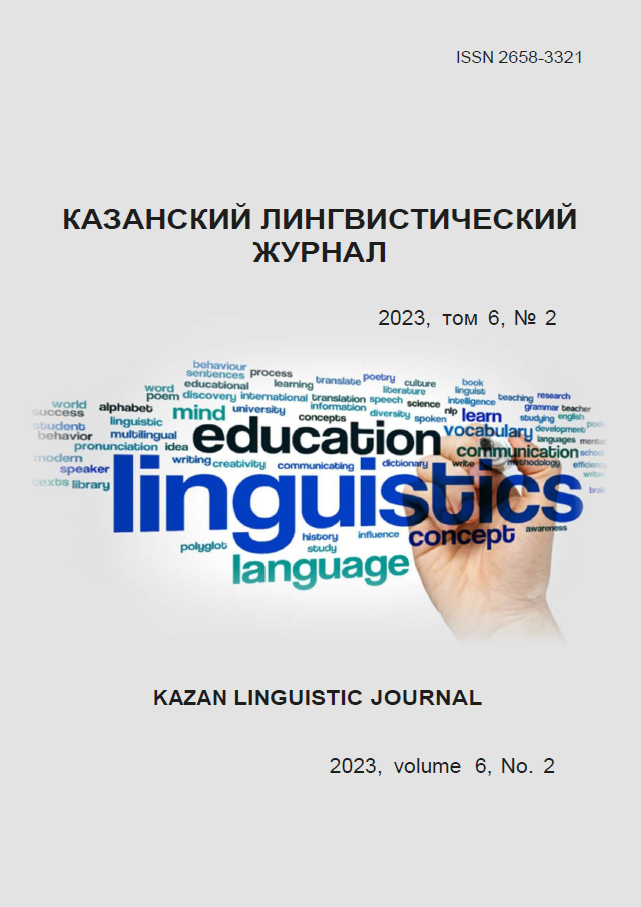Color Symbolism in the Story “The Black Monk” by A.P. Chekhov
https://doi.org/10.26907/2658-3321.2023.6.2.155-164
Keywords:
color symbolism, color designation, color painting, Russian literature, The Black Monk by A.P. ChekhovAbstract
Recently, the interest of literary critics in the study of color painting in the work of poets and writers has increased, the analysis of whose works allows us to reveal the semantics of color, the state and inner world of heroes. Color painting is an integral element of A.P. Chekhov, therefore, the study of the coloring of the writer's prose is an urgent problem. The article is devoted to the poetics of color designations in A.P. Chekhov "The Black Monk". The colors that form the main coloristic background of the story are highlighted. Black, white, red colors show the complex inner experiences and state of mind of the main characters of the hero, convey their rich emotional world and at the same time create grounds for ambiguous interpretation of their images and the meaning of the story as a whole. The article proposes a comparative analysis of the canonical meanings of basic colors and their functions in Chekhov's text. It is shown what role the combination of basic colors plays in the meaning formation of the story. On the example of the analysis of portrait characteristics and landscape fragments, the techniques that form the ambiguity of color semantics are highlighted. In conclusion, it is emphasized that thanks to the color painting in the story, there is scope for the associative work of the reader's imagination, a metaphorical connection is formed between its characters and the author's position is expressed.
References
References
Turner V.U. Symbol and ritual. M.: Mir; 1983. (In Russ.)
Serov N.V. Chromatism of the myth. Leningrad: Vasilievsky Island; 1990. (In Russ.)
Florensky P.A. Iconostasis. Selected Works on Art. St. Petersburg: Mithril; 1993. (In Russ.)
Kochnova K.A. Questions of studying the writer's linguistic picture of the world. Humanitarian scientific research. 2014;11(39):51–54. (In Russ.)
Isaev A.A., Teplykh A.A. Philosophy of color. The phenomenon of color in thinking and creativity. M.: Flinta; 2011. (In Russ.)
Frumkina R.M. Color, meaning, similarity. Aspects of psycholinguistic analysis. M.: Nauka; 1984. (In Russ.)
Losev A.F. The problem of the variable functioning of pictorial imagery in fiction. Literature and painting. L.: Science; 1982. p.31–65. (In Russ.)
Shtengelov E. Color in fiction. Science and life. 1970;(8):24–26. (In Russ.)
Osipova Yu.V. The symbolism of color in Pushkin's story "The Queen of Spades". Problems of modern science and education. 2020;6–1(151):42–47. (In Russ.)
Iyulskaya E.G. Color symbolism in the fairy tales of A.S. Pushkin. East European scientific journal. 2018; 3–5(31): 65–69. (In Russ.)
Trufanova M.I. The functions of color in the verbal portraits of L. Tolstoy and D. Galsworthy (on the example of the works "Anna Karenina" and "The Forsyte Saga"). Bulletin of the Moscow State Regional University. 2019;(2):71–78. (In Russ.)
Chernyak V.D. The color palette of Yu. Kazakov's stories: lexical embodiment. Pro-ceedings of the Russian State Pedagogical University. A.I. Herzen. 2017;(184):26–30. (In Russ.)
Golovacheva A.G. Colors and smells in A.P. Chekhov "The Bride". Literature at school. 2011;(3):8–10. (In Russ.)
Chekhov A.P. Black Monk. Full coll. op. and letters. T.8. Moscow: Nauka; 1977. pp. 226–257. (In Russ.)
Khatkova I.N. Psychasthenic world of A.P. Chekhov in the story "The Black Monk". Culture. Spirituality. Society. 2013;(6):79–83. (In Russ.)
Evdokimova O.K. The concept of "garden" in Russian and Chuvash literature of the XIX - XX centuries. (A.P. Chekhov, I.A. Bunin, A.S. Artemyev). Bulletin of the Chuvash State Pedagogical University. AND I. Yakovlev. 2017;3(95):50–58. (In Russ.)
Ivanshina E.A. From intertexts to meaning: on the optics of A.P. Chekhov "The Black Monk". Bulletin of the North-Eastern Federal University. M.K. Ammosov. 2022;2(88):78–88. (In Russ.)






